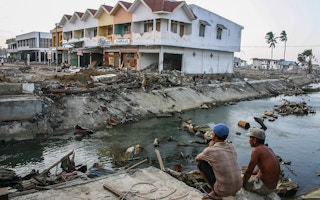While urban planning is one of the key responsibilities of local government, in many cases and locations these authorities do not have sufficient financial, technical and human resources to lead a complex urban planning process.
There is also extra pressure after humanitarian crises, when it is necessary to balance the immediate needs of the affected residents with opportunities to reduce the risk of future disasters through improved urban development.
If humanitarian agencies are to help cities recover and rebuild after a crisis, they must work closely with local governments, and providing support for urban planning processes is an important area of focus. However, there is limited research to provide guidance on how this can be done well.
Humanitarians can help, but how?
Our research project, funded through IIED’s Urban Crises Learning Fund, compared two case studies where humanitarians supported local governments with their urban planning activities after a crisis.
The first case study looked at Indonesia, where UN-Habitat supported urban planning in Meuraxa—one of the worst affected districts in Banda Aceh after the Indian Ocean earthquake and tsunami in 2004.
“
Supporting local governments and communities with urban planning is a relatively new angle for humanitarian agencies, but one that is likely to become increasingly important in future responses.
The second is in the Philippines, where urban planners from UN-Habitat supported municipal authorities in Tacloban, Ormoc and Guiuan after the 2013 super typhoon Haiyan. Lessons learned from the two largest cities (Banda Aceh and Tacloban) were also analysed to better understand how transferable the approach was to other cities in the future.
Empowering local governments and communities
Our research confirmed the importance of urban planning. We found that the planning process helped urban communities and local governments to identify their own needs and priorities for recovery.
The support role for humanitarians was also brought into focus. In both countries, ongoing mentoring and technical support from UN–Habitat grew the urban planning skills and knowledge of local government staff, as well as introducing them to useful tools, technologies and frameworks.
Three key lessons
Based on the findings of our research, we recommend:
- Integrating urban plans from the start. Humanitarian agencies seeking to provide support in future urban crises should consider from the beginning how plans can be integrated across sectors, scales and phases. This can take a long time, cause delays—for example if you need one plan to be finished before you start another—and require specialist technical input.
- Rapidly develop a city-level plan. This can then be used immediately as part of the humanitarian response, as well as being useful as the starting point to identify more detailed sectoral, participatory or geographically targeted plans (an area-based approach) that are necessary for reconstruction and development planning.
It is likely to be difficult to run a very participatory process with a large number of stakeholders when rapidly developing a city-level plan. However, inclusion should be a priority in subsequent planning activity so that local people are involved in making decisions that affect them, and can identify their own needs.
- Establishing an urban forum or task force. A task force convened to lead urban planning activities should be set up as soon as possible after a crisis, and include representatives from local and national government, civil society, humanitarian and development agencies, the private sector and academia.
Ideally, a task force would be convened or mandated by a prominent city government official, such as the mayor, as this gives the group greater authority and credibility. A key role of the task force would be to share discussions from a city-level forum with all stakeholders—and particularly the affected communities—so everyone knows what is happening and there is a two-way communication channel.
A future focus on urban planning
Involving the right people in the right decisions at the right time is critical for reducing urban vulnerability and improving the lives of the people who live and work in cities affected by crises.
Supporting local governments and communities with urban planning is a relatively new angle for humanitarian agencies, but one that is likely to become increasingly important in future responses.
Elizabeth Parker is an independent consultant whose research focuses on humanitarian response, climate change and urban development. This post is republished from the IIED blog.










